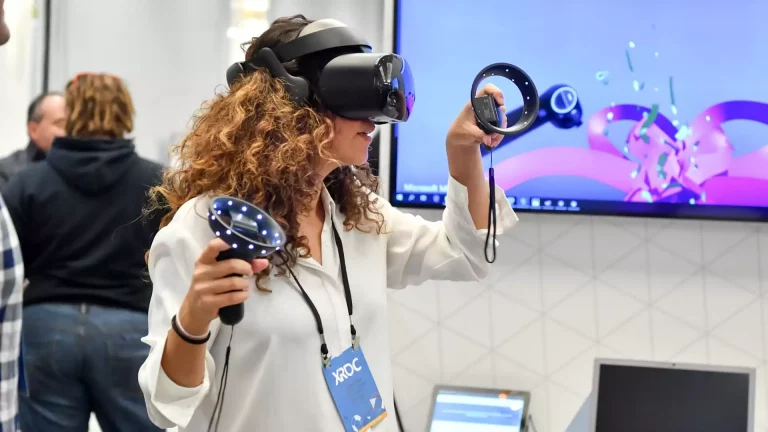
VR offers exciting possibilities for catering to different learning preferences and needs. Many opportunities stem from adaptive learning algorithms that adjust the course content or other particulars in real time.
Personalizing the training experience for students or workers with diverse needs should increase their comprehension and enjoyment. What can VR designers do when creating these products and course modules?
Offer Options to Change the Background Elements
Designers should incorporate user-friendly features that allow people to alter the learning environment to improve their concentration. One study investigated the impact of VR on individuals with differences in brain functionality — sometimes called neurodivergence — who could change the VR environment to suit their learning needs.
One of the study’s main goals was to determine how environmental distractors affected the completion times and accuracy of educational exercises. One takeaway was that more distracting environments negatively affected both of those metrics. Additionally, when the VR setting’s lighting was too high or low, people performed slower and less accurately than in optimal conditions.
Another finding was that increased distractions caused a more significant adverse effect on neurodiverse individuals than peers without neurodiversity. Additionally, those individuals performed some learning tasks better if loud background noise accompanied the content rather than silence.
These substantial variations among different groups illustrate the importance of including user-facing controls that allow people to change settings and create the ideal learning environment. Alternatively, designers can investigate options that automatically change the environment after detecting performance- or comprehension-related drops.
Account for Device-Related Differences
An emerging web design trend involves adapting the layout to match different screen sizes. That approach leads to faster loading times and better performance across devices. VR designers should apply a similar technique when creating products featuring adaptive learning algorithms.
VR device capabilities vary significantly. Although these products have recently become more accessible due to gradual price reductions and better commercial availability, differences exist in what learners can access. Some of the most basic virtual reality applications work on smartphones that people attach to cardboard accessories that facilitate viewing.
A related consideration is that people worldwide may use VR applications, so designers must accommodate location-related resource differences. One example comes from an Arizona State University project that brings artificial intelligence and virtual reality applications to educators in Argentina through a faculty training initiative.
The Argentinian program has 42,000 undergraduate and graduate-level learners, and more than 2,000 faculty members will participate in this opportunity. While developing this training program, participants accommodated the local educational landscape and contextual needs.
In any case, developers must address the reality that learners may use multiple devices across their educational experiences. Consider, for example, someone who uses a more advanced VR device at home than in school or vice versa. Creating the content to respond accordingly will reduce friction, which may decrease learning.
A Virtual-First Workforce: Designing the Future of Remote Collaboration
Use VR to Prepare Learners for Future Stressors
Many modern educational settings emphasize test preparation because numerous learning environments use standardized exams to gauge performance. However, test performance is only one indicator of aptitude and readiness for particular experiences, and only one factor considered during the college acceptance or workplace recruitment process. Consider, for example, how approximately 90% of students with GPAs above 4.0 who achieve perfect SAT scores are still not accepted to the top 10 universities.
That suggests admissions professionals look for aspects beyond grades and scores. They want to find passionate students who bring unique and vital benefits and enthusiasm to university campuses. Flexible VR modules could base education off what excites its learners most to unlock their learning potential.
Relatedly, exam anxiety is a common reason why people perform below expectations on standardized tests. Research suggests adaptive VR modules could make people more stress-resilient by increasing their preparedness for things they will find stressful later. In one case, designers created a personalized and adaptive training program through a VR solution that provided graduated stress exposure to astronauts.
Participants trained in one of three VR environments — stressor-free, adaptive or prescheduled stressors. Those exposed to the adaptive environment had lower heart rates and more favorable heart rate variability ratios than people in the other two groups. Additionally, learners were less distressed and more engaged in the adaptive environment.
These results illustrate how applying adaptive VR scenarios to other learning needs is worthwhile. Most people — from graduate students to construction workers — experience occasional high-stress situations or environments. Getting strategies to cope with them in advance could optimize outcomes and elevate overall competency under pressure.
Real-Time Rendering Optimization for XR: 7 Challenges and Tips
Let Learners Guide VR Decisions
Rely on the above tips and examples while evaluating what is possible for your upcoming projects. You should always listen to feedback from potential users and let it shape development choices. Those individuals have valuable perspectives that may highlight unique challenges and help create a more effective, well-rounded VR experience.
 Eleanor Hecks is Editor-in-Chief of Designerly Magazine where she specializes in design, development and UX topics. Follow Designerly on X @Designerlymag.
Eleanor Hecks is Editor-in-Chief of Designerly Magazine where she specializes in design, development and UX topics. Follow Designerly on X @Designerlymag.

